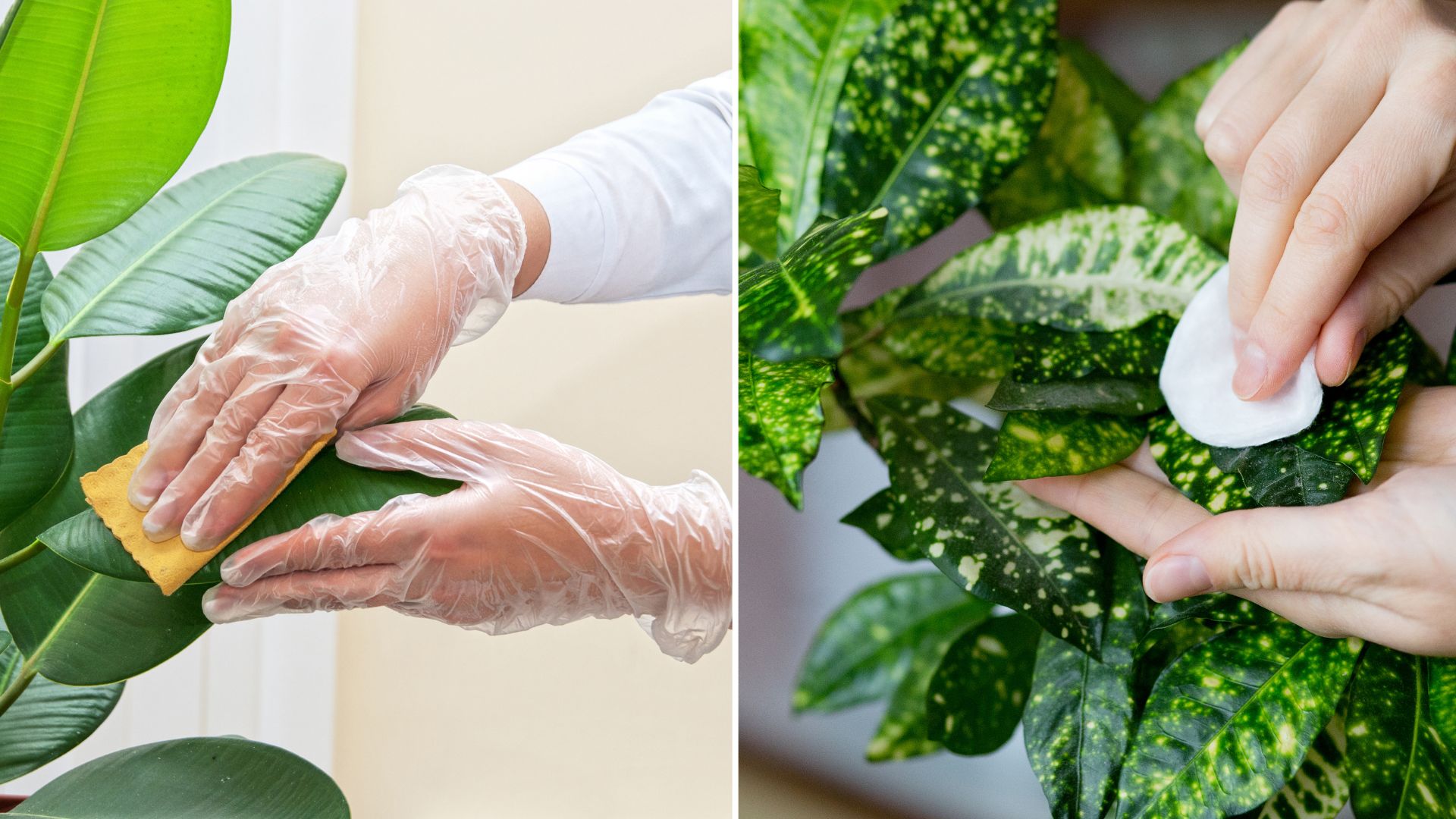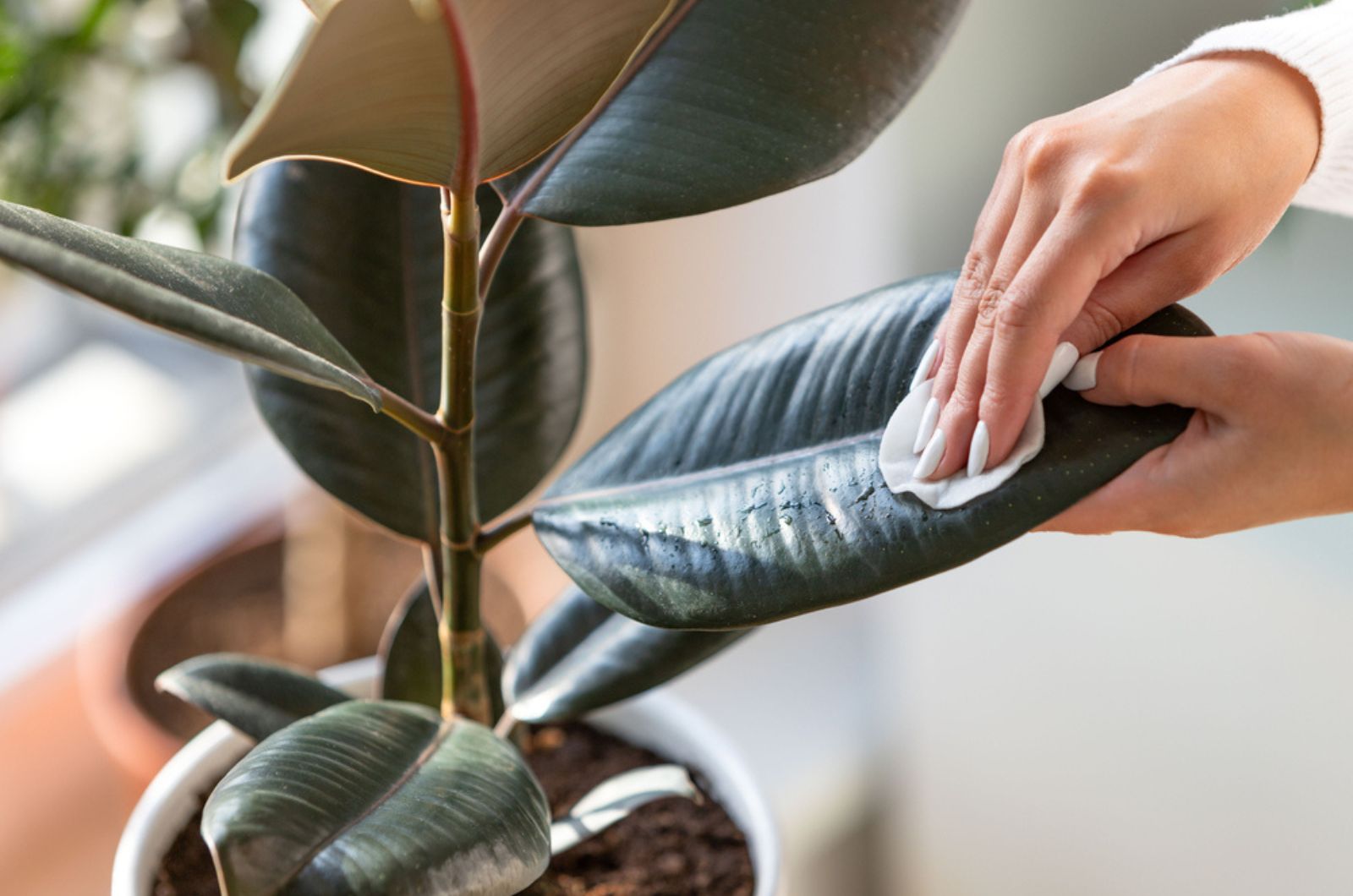There are many chores to complete on a daily basis; from pampering our pets to sanitizing our living spaces.
If you’re a plant parent, you should know that cleaning houseplants is another chore that must be done. Our beautiful green buddies are real dust gatherers!
We don’t clean our plants only for their appearance, but also to maintain their health.
Dust that collects all over the leaves can actually be dangerous and harm your houseplants because it prevents the sunlight from reaching the foliage. As a result, the leaves can’t perform photosynthesis and our plants display poor growth.
Don’t worry; I’ll show you how to clean houseplant leaves and keep them happy and healthy all year long!
1. Choose Suitable Tools And Supplies
Once you put cleaning your indoor plants on your to-do list, you should gather the proper tools and supplies. Some of you may think that rubbing the leaves with a cloth is enough, but there’s more to it than meets the eye.
Houseplants come in different sizes and shapes, and it’s not the same to clean huge Monstera leaves as it is for small pothos leaves.
This is why we must add more items to our plant care kit.
Here are some essentials for cleaning:
• Clean spray bottle or mister
• Soft cleaning cloth
• Paintbrush
• Cotton balls
• Paintbrush with a fine tip
• Q tips
2. Here’s How To Clean Houseplants With Smooth And Glossy Leaves
When it comes to cleaning, we can divide our houseplants into three main categories: those with smooth and glossy leaves, those with feathery leaves, and succulents and cactuses.
Let’s start with shiny leaves, such as those of Philodendrons, Monsteras, and Fiddle leaf figs.
Things are pretty straightforward here; all you need is a soft microfibre cloth and clean water. Wet the cloth and rub the leaves but make sure to support them while cleaning to avoid damage.
Some growers use leaf shine products or homemade solutions such as mixing milk and water. Honestly, I haven’t tried these methods because I’m satisfied with the results of using only water.
However, if you notice some pests on the surfaces and undersides of the leaves, then water isn’t enough.
In this case, I recommend using a combination of soap and water.
The leaves of tall plants that have reached their mature stage may not be easy to clean. If there aren’t any pests, do not move the plant or try to reach the leaves on the top to rub them with water. A feather duster saves the day!
3. Cleaning Houseplants With Feathery Leaves
The Asparagus fern or Fluffy Ruffle fern make an amazing addition to houseplant collections. And, of course, they owe it to their splendid feathery leaves.
But their beauty comes with a price. It’s pretty hard to clean the leaves of these plants because they’re delicate and even a little force can break them.
A clean and soft paintbrush is your best friend now. Gently brush the leaves and if all the dust isn’t cleaned, dip the brush in lukewarm water and repeat the process.
If your ferns are still juvenile or you grow dwarf varieties, use as small and soft a brush as possible.
After you’re done with cleaning, fill the plant mister with clean, room temperature water and mist your ferns. This will slightly increase the humidity around these plants and result in healthier growth.
If you grow some leafy plants, such as indoor palms, clean their leaves with a soft damp cloth.
4. Cleaning Succulents And Cactuses
The first that comes to mind for many people when cactuses are mentioned is the prickly stems. Well, it may be challenging to clean thorny cactuses, but it’s not impossible.
You only need a dry paintbrush! Do not use water when cleaning these plants. Simply stroke between the spikes and collect as much dust as possible.
If your cactuses are still small, clean them using Q tips. It’s also a good idea to wear gloves while handling cactuses in general.
For succulents, run a clean and soft cloth over the leaves and you’re good to go. Don’t pour water over the leaves or spritz them because they can rot.
5. Cleaning Indoor Plants Leaves In A Bucket Of Water
If your plant collection has smaller plants, consider cleaning them using a bucket of water. This method is probably the most interesting but I have to admit that it does take some skill, no matter what others say.
So, here’s the deal. First, you pour clean, lukewarm water into the bucket. Then, hold the base of your prized houseplant at the soil surface and turn it upside down. Submerge the plant and move the leaves around the water carefully.
If you’re afraid that your plant will fall out of its pot, you can cover the base with a plastic wrap to keep everything in place.
After you take your plant out, allow it to dry well and then return it to its original location.
You can add a few drops of dish soap to the water if there is some grime from cooking on the leaves.
What Not To Use For Cleaning Houseplants
Plant parents sometimes get carried away and clean their green buddies with different products.
For instance, some suggest using baby wipes for cleaning plant leaves without realizing how dangerous it can be. Chemicals and alcohol are often found in these products and we all know the threat they pose to delicate foliage.
Mayonnaise, egg whites, and other foods are also recommended by some growers. Well, is there really a need to explain why we shouldn’t use these? Leaves breathe and if you clog their pores, they’ll retain too much water and even attract pests.
Finally, neem oil and olive oil are also used for cleaning plant leaves, and while they aren’t as dangerous as the above mentioned ones, you should still be very careful.
Your main goal is to clean the leaves, not to damage them. Water, as always, does the best job. If there aren’t any pests and dust is the only issue, don’t be tempted to add anything to the water because it can do more harm than good.




